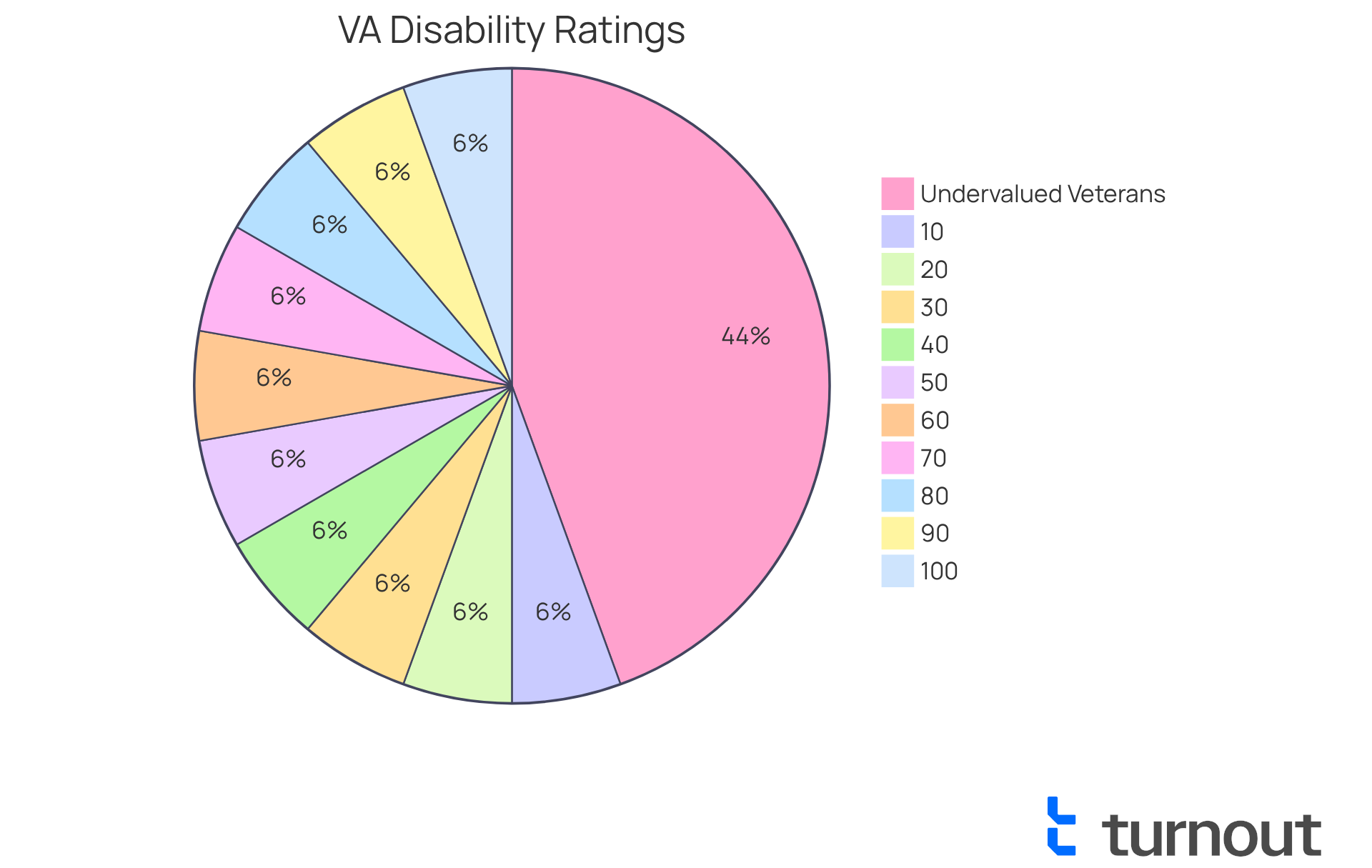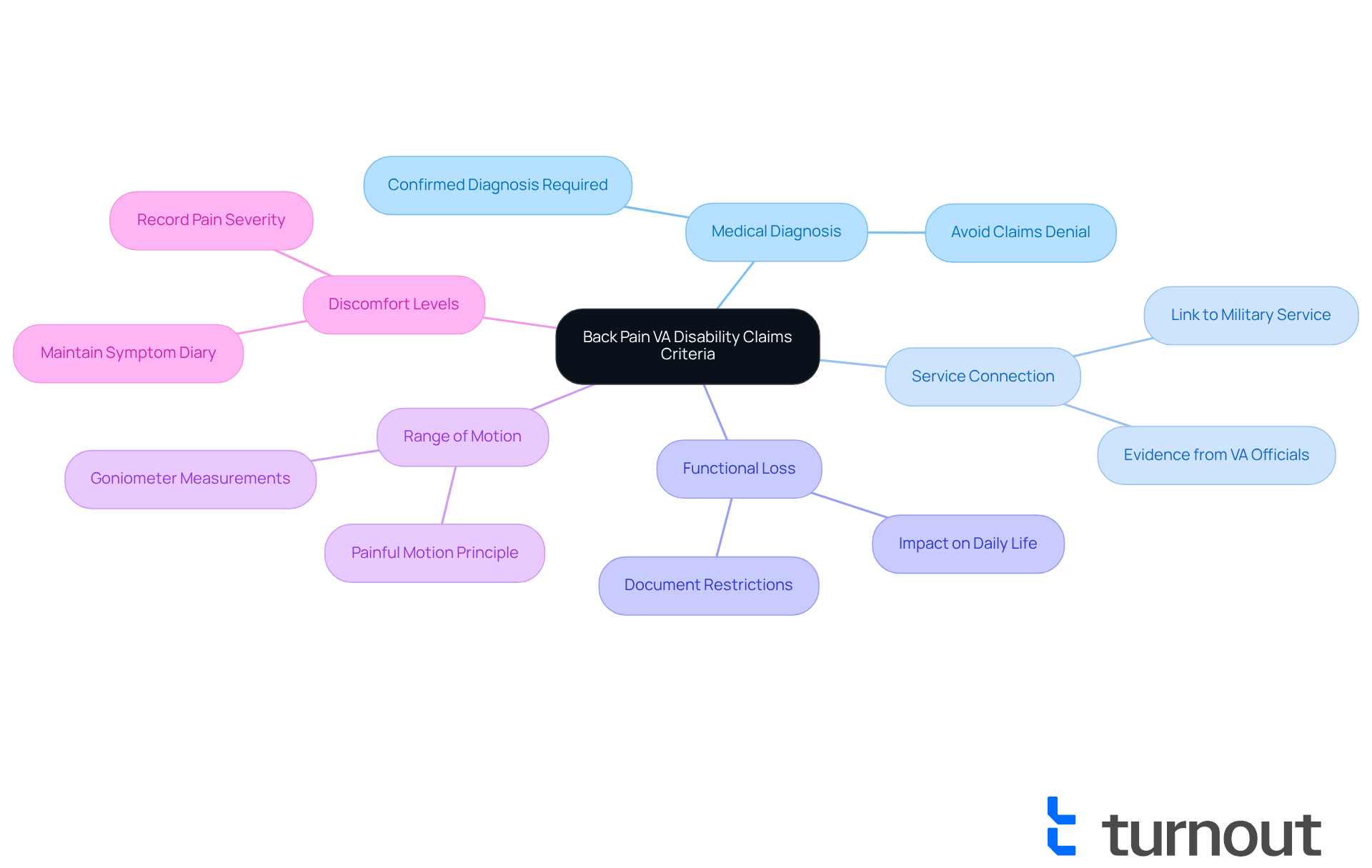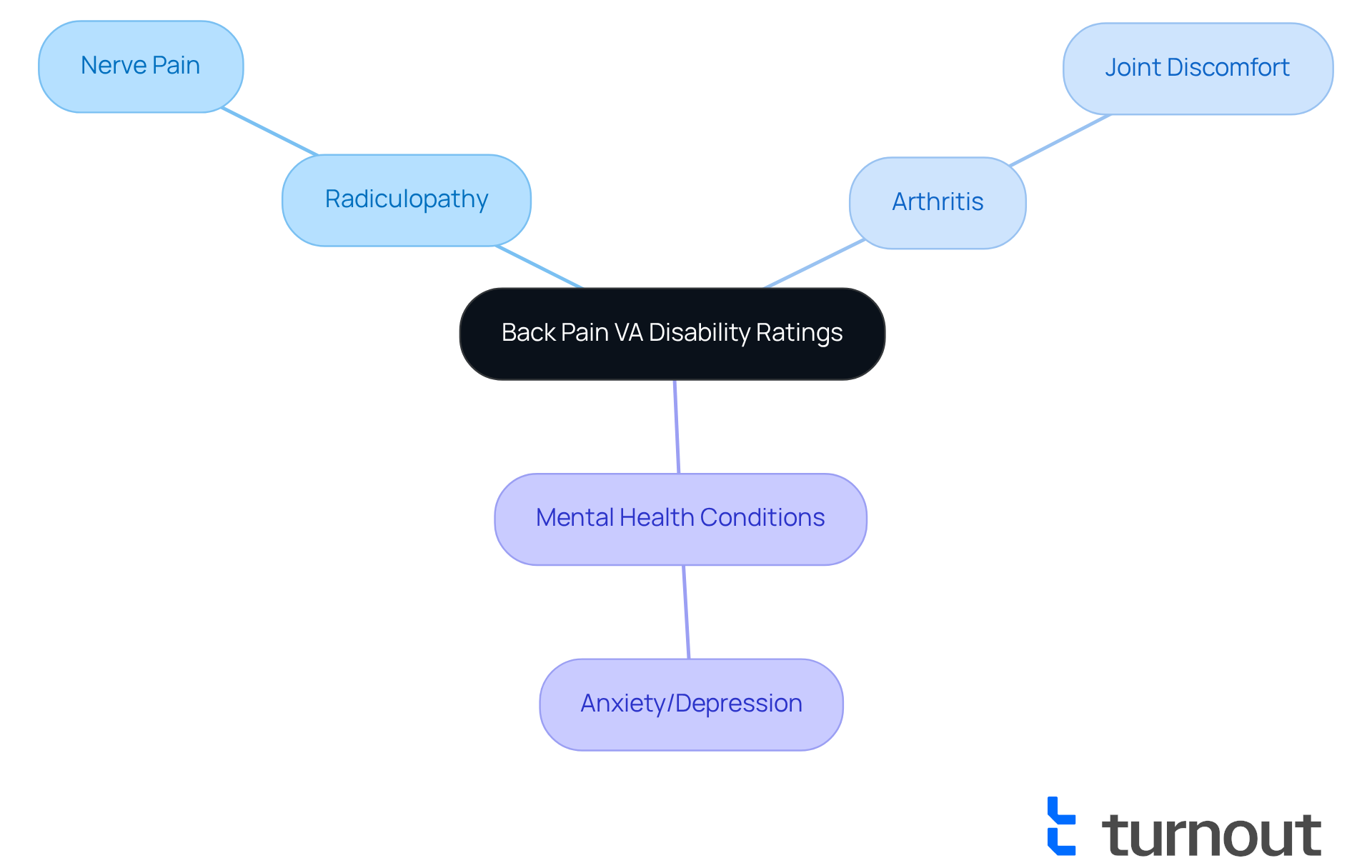Overview
Understanding VA disability ratings for back pain is crucial for many veterans. These ratings can range from 10% to 100%, depending on how severe the condition is and how it affects daily life. We understand that navigating this process can be overwhelming, and it’s common to feel undervalued in your ratings. Unfortunately, many veterans miss out on significant compensation due to this.
Thorough documentation is vital in supporting your claims. This includes gathering medical records and personal statements that reflect your experiences. Remember, you are not alone in this journey. We’re here to help you ensure that your situation is fully understood and accurately represented.
By taking these steps, you can advocate for yourself and potentially improve your rating. It’s important to recognize the impact that back pain can have on your life and to seek the compensation you deserve. Don’t hesitate to reach out for assistance; together, we can navigate this process.
Introduction
Navigating the complexities of VA disability ratings for back pain can feel overwhelming for many veterans. We understand that this process is crucial, as it can significantly impact the compensation and benefits you may receive. With a staggering 80% of veterans potentially undervalued in their claims, the stakes are high—especially when it comes to securing the necessary medical care and support services.
How can you ensure that you are accurately represented in your evaluations? What steps can you take to maximize your disability ratings? This article delves into essential insights and strategies to help you effectively navigate the VA disability rating process for back pain. Remember, you are not alone in this journey; we’re here to help you every step of the way.
Clarify VA Disability Ratings for Back Pain
The VA determines through the , based on the seriousness of the condition and its impact on daily activities. Ratings typically range from 10% to 100%, with higher percentages indicating more severe disabilities. It’s important to note that while the typical [back pain VA disability rating](https://vaclaimsinsider.com/va-disability-ratings-for-back-pain-the-definitive-guide) for spinal discomfort is around 10%, this can significantly increase depending on the severity of the ailment, such as unfavorable ankylosis or limitations in range of motion. The evaluation process considers several factors, including the diagnosis, the extent of functional impairment, and the results of medical examinations, like the Compensation and Pension (C&P) exam.
We understand that navigating this process can feel overwhelming. Veterans must present to substantiate their claims, which include:
- Diagnosis reports
- Treatment history
- Personal statements explaining how discomfort in their lower bodies affects their
Many former service members have successfully obtained to incidents related to their service. This highlights the significance of a .
Comprehending these evaluations is vital for former service members, as it aids them in predicting the . This compensation can encompass essential benefits such as and job training services. Furthermore, it’s significant to note that around 80% of former service members are undervalued by the VA, indicating they could be losing thousands of dollars in tax-exempt compensation each month. This underscores the need for veterans to be thorough and honest about their symptoms during evaluations to ensure they receive the ratings they deserve. Remember, you are not alone in this journey; we're here to help you through it.

Examine Key Evaluation Criteria for Back Pain Claims
Navigating back pain can be challenging, but understanding the evaluation criteria can significantly enhance your chances of success. Here are several key factors to consider:
- : It’s essential to have a confirmed diagnosis of your back condition. Claims without a clear medical diagnosis often face denial, with many veterans experiencing this frustration.
- : You’ll need to provide evidence that your spinal condition is linked to your military service. This connection is vital for securing benefits. Quotes from VA officials can clarify what qualifies as a service connection, providing you with the guidance you need.
- : The VA looks closely at how your condition affects your daily life and work. We encourage you to document any restrictions caused by your and gather proof from employers or caregivers about how it impacts your everyday activities. This evidence can strengthen your claim.
- Range of Motion: Medical examinations will measure your movement limitations. Accurate goniometer measurements are crucial to illustrate the severity of your condition. Remember, under 38 CFR §4.59, if you experience discomfort during movement, you may qualify for a minimum 10% rating for [back pain VA disability rating](https://vaclaimsinsider.com/va-disability-ratings-for-back-pain-the-definitive-guide), even if your range of motion appears complete.
- : Keeping a record of your discomfort severity and its impact on your daily life is essential. We suggest maintaining detailed notes about your pain experiences, including flare-ups and daily challenges. A symptom diary or medication list can be invaluable during your C&P exam.
By ensuring your medical records reflect these criteria, you can bolster your claims effectively. Remember, you are not alone in this journey. With thorough documentation and evidence, you can greatly enhance your likelihood of receiving the appropriate back pain VA disability rating for your spinal discomfort. We're here to help you every step of the way.

Assess Functional Loss and Range of Motion Limitations
Functional loss can be a challenging reality for veterans, as it refers to the inability to perform normal activities due to back pain, which is relevant to their VA disability rating. We understand how deeply this can impact your daily life. The VA evaluates this through several key assessments that can help you articulate your struggles:
- : These tests measure how well you can move your back in various directions. Limited mobility can significantly affect your disability assessment. Typically, the for is around 10%, but it can vary from 10% to 100% depending on the severity and functional impairment you experience.
- : It's important for you to carefully record how discomfort in your spine influences your daily tasks, such as walking, lifting, or sitting for long periods. Many former service members report that their back pain affects their back pain VA disability rating and restricts their ability to engage in daily activities. This documentation can serve as vital evidence in your claims. In fact, statistics show that 80% of former service members feel underrated by the VA, highlighting the need for .
- Discomfort During Movement: Even if your range of motion seems normal, the discomfort you feel during movement can still contribute to your . The VA's '' guideline allows service members to receive at least a minimum compensable evaluation, even if they demonstrate a complete range of motion, as long as they experience discomfort. This is particularly important as many former service members may not receive the evaluations they deserve due to insufficient reporting of their discomfort levels.
We encourage you to maintain a detailed log of your symptoms and limitations. This comprehensive documentation can significantly strengthen your case during evaluations. Accurate range of motion measurements, along with thorough documentation of how your daily activities are affected, are crucial for obtaining the back pain VA disability rating. Remember, spinal discomfort can lead to additional issues, which may also be considered in your claims. You're not alone in this journey, and we're here to help you navigate it.

Explore Multiple Ratings and Secondary Conditions Related to Back Pain
Veterans may qualify for multiple disability ratings if they have more than one . We understand that dealing with can be challenging, and matters even further. These may include:
- Radiculopathy: This refers to nerve pain that radiates from the back to the limbs, often stemming from spinal issues.
- Arthritis: Joint discomfort can arise due to changed posture from ongoing spinal issues, making movement and everyday tasks more difficult.
- Mental Health Conditions: Chronic discomfort can lead to anxiety or depression, significantly affecting your quality of life.
The Department of Veterans Affairs defines secondary conditions as those caused or aggravated by an existing service-connected disability. When submitting claims for secondary conditions, it's crucial for former military personnel to present linking these conditions to their primary back pain VA disability rating. This includes medical records and buddy statements.
It's common to feel overwhelmed by the VA's complex rules, but remember, you are not alone in this journey. The VA recognizes that secondary conditions can complicate both personal and work life. They allow for combining ratings through the Combined Ratings Table, which can lead to a . This, in turn, increases your monthly compensation, making it essential to understand how to navigate these claims effectively.
Many former service members have shared their experiences, noting that ' can increase your overall disability rating.' This highlights the potential for enhanced compensation regarding back pain VA disability rating through diligent claim preparation. Additionally, veterans have the right to appeal the VA's initial decision regarding their claims, which can further empower you in the process. We’re here to help you secure the benefits you deserve.

Conclusion
Navigating the complexities of VA disability ratings for back pain can be overwhelming for veterans seeking the benefits they deserve. Understanding the rating system, which ranges from 10% to 100%, is essential for service members to anticipate their compensation based on the severity of their spinal conditions. Many veterans are currently receiving less compensation than they are entitled to, with approximately 80% undervalued by the VA. This is a reality that can cause frustration and concern.
Throughout this journey, it's important to be aware of the evaluation criteria necessary for successful claims. Key factors include:
- A confirmed medical diagnosis
- Evidence of service connection
- Documentation of functional loss
- Detailed records of discomfort levels
These elements all play a significant role in determining the appropriate disability rating. Additionally, understanding secondary conditions related to back pain, such as radiculopathy and mental health issues, can enhance a veteran's claim, potentially leading to higher overall ratings and compensation.
Ultimately, securing a fair VA disability rating for back pain requires thorough preparation and diligent documentation. We encourage veterans to take proactive steps in their claims process. Maintaining symptom diaries and gathering supportive medical evidence can significantly improve their chances of receiving the benefits they rightfully deserve. Remember, you are not alone in this journey; your sacrifices deserve to be honored and supported.
Frequently Asked Questions
How does the VA determine disability ratings for back pain?
The VA determines disability ratings for back pain based on the seriousness of the condition and its impact on daily activities. Ratings typically range from 10% to 100%, with higher percentages indicating more severe disabilities.
What is the typical VA disability rating for spinal discomfort?
The typical back pain VA disability rating for spinal discomfort is around 10%, but it can increase significantly depending on the severity of the ailment, such as unfavorable ankylosis or limitations in range of motion.
What factors are considered during the evaluation process for back pain disability ratings?
The evaluation process considers several factors, including the diagnosis, the extent of functional impairment, and the results of medical examinations, such as the Compensation and Pension (C&P) exam.
What medical records do veterans need to provide to support their claims?
Veterans need to present thorough medical records, which include diagnosis reports, treatment history, and personal statements explaining how their back pain affects their daily lives.
How can veterans enhance their evaluations for back pain disability ratings?
Many former service members have successfully obtained enhanced evaluations by linking their back pain VA disability rating to incidents related to their service, emphasizing the importance of a reliable nexus letter.
Why is it important for veterans to understand their evaluations?
Understanding these evaluations is vital for former service members as it helps them predict the compensation they might receive, which can include essential benefits such as medical care and job training services.
What percentage of former service members are undervalued by the VA?
Around 80% of former service members are undervalued by the VA, indicating they could be losing thousands of dollars in tax-exempt compensation each month.
What should veterans do during evaluations to ensure they receive the ratings they deserve?
Veterans should be thorough and honest about their symptoms during evaluations to ensure they receive the ratings they deserve.




